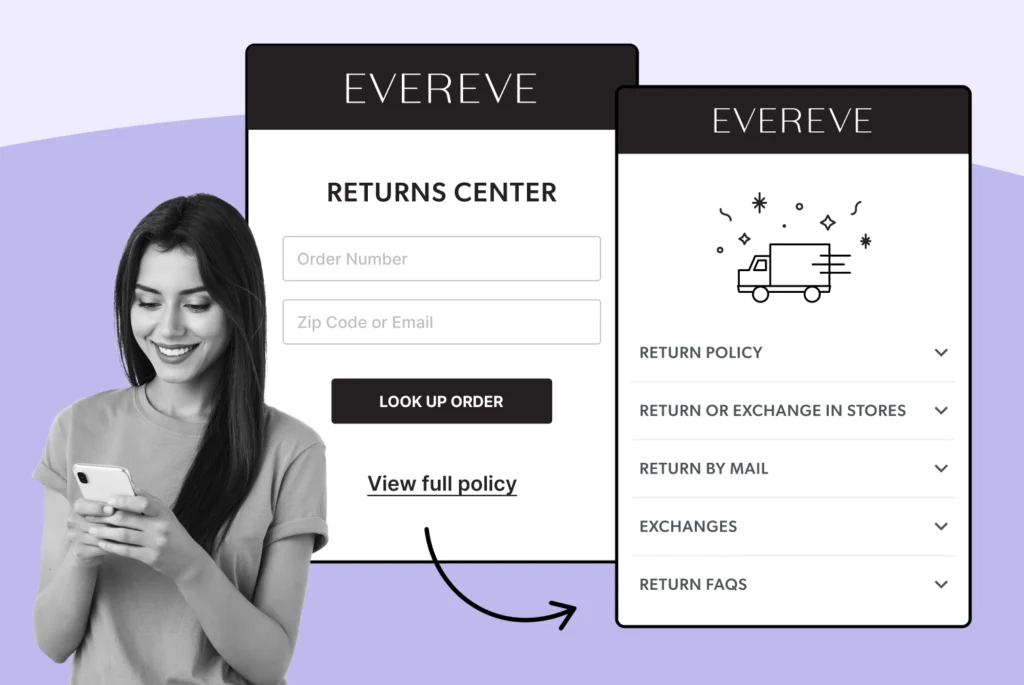
How Can Pre-Launch Failure Analysis Help Prevent Returns?
Learn how to optimize packaging for hassle-free returns and exchanges. Enhance customer satisfaction and streamline your process. Read the guide now!
Shipping, Tracking & Notifications
Boost customer experience and reduce support tickets
Realtime order and shipment tracking
Proactive order and shipping notifications
AI-Enhanced Discounted Labels
Predictive pre-purchase estimated delivery dates
Self-Serivce branded order tracking
Effortless experience delivered
Identify and Resolve Order Issues
Realtime order and shipment tracking
Make returns profitable and delight customers
Flexibility to define any return destinations & conditions
Simplify returns for your customers and team
Incentivize exchanges over returns
Returns management made easy for your team
Returns management made easy for your team
Easy claims and smart upsells
Understand why your customers are returning
In-Store & Curbside Pickup
Unify the online and the in-store experience
Hassle-free pickup experience for customers
In-Store dashboard to keep operations streamlined
In-Store and Online orders unified
Drive foot-traffic to your stores
Shipping, Tracking & Notifications
Boost customer experience and reduce support tickets
Realtime order and shipment tracking
Proactive order and shipping notifications
AI-Enhanced Discounted Labels
Predictive pre-purchase estimated delivery dates
Self-Serivce branded order tracking
Effortless experience delivered
Identify and Resolve Order Issues
Realtime order and shipment tracking
Make returns profitable and delight customers
Flexibility to define any return destinations & conditions
Simplify returns for your customers and team
Incentivize exchanges over returns
Returns management made easy for your team
Returns management made easy for your team
Understand why your customers are returning
In-Store & Curbside Pickup
Unify the online and the in-store experience
Hassle-free pickup experience for customers
In-Store Dashboard to keep operations streamlined
In-Store and Online orders unified
Drive foot-traffic to your stores
Boost customer experience and reduce support tickets
Realtime order and shipment tracking
Proactive order and shipping notifications
AI-Enhanced Discounted Labels
Predictive pre-purchase estimated delivery dates
Self-Serivce branded order tracking
Effortless experience delivered
Make returns profitable and delight customers
Flexibility to define any return destinations & conditions
Simplify returns for your customers and team
Incentivize exchanges over returns
Returns management made easy for your team
Equip your team for precise return checks.
Understand why your customers are returning
Unify the online and the in-store experience
Hassle-free pickup experience for customers
In-Store Dashboard to keep operations streamlined
In-Store and Online orders unified
Drive foot-traffic to your stores
Find the answer to all your questions
Take a step by step trip through our functionality to see how we can improve your ecommerce processes.
Explore the most comon questions about WeSupply
Calculate the ROI that WeSupply can bring you
Request a no strings attached review of your current shopping experience and missed conversion opportunities
Read actionable articles on how to optimize your post-purchase experience and decrease support tickets
Get inspired by stories of how our customers implemented an effortless post-purchase experience
Wondering if WeSupply is a good fit for you? Read through our use cases to see how we can help you increase conversion & improve CX!
A Deep Dive into Top Companies' Order Tracking & Returns Strategy
Find the answer to all your questions
Explore the most comon questions about WeSupply
Calculate the ROI that WeSupply can bring you
Request a no strings attached review of your current shopping experience and missed conversion opportunities
Take a step by step trip through our functionality to see how we can improve your ecommerce processes.
Read actionable articles on how to optimize your post-purchase experience and decrease support tickets
Get inspired by stories of how our customers implemented an effortless post-purchase experience
A Deep Dive into Top Companies' Order Tracking & Returns Strategy
Wondering if WeSupply is a good fit for you? Read through our use cases to see how we can help you increase conversion & improve CX!

Ecommerce returns are an inevitable part of online shopping. According to the National Retail Federation (NRF), the average return rate for e-commerce purchases is 16.9%. However, while returns are an expected part of the process, they are also costly. Retailers often face significant financial losses due to return-related expenses such as shipping, restocking, and the depreciation in value of returned items. In fact, the costs of handling returns can range from 20% to 65% of the item’s original value.
For Shopify merchants, managing these returns effectively is crucial to maintaining profitability. A well-crafted return policy is essential for balancing customer satisfaction with fraud prevention. Moreover, by leveraging return management apps and Shopify’s built-in features, businesses can streamline their returns processes and mitigate the financial burden that comes with returns. However, one practice that many e-commerce businesses adopt— including Shopify return labels in the box—might seem convenient but can actually exacerbate these challenges. This article will explore the reasons why including return labels in the box may not be the best strategy for Shopify merchants and how tailoring return policies to specific business needs can offer a more effective solution.
The return process is a critical aspect of ecommerce businesses, as it directly impacts customer satisfaction and loyalty. A well-designed return process can help retailers reduce returns, improve customer satisfaction, and increase revenue. Typically, the return process involves several key steps: initiating a return, generating a return shipping label, shipping the item back to the retailer, and processing a refund or exchange.
Retailers can leverage return management apps, such as those available in the Shopify App Store, to streamline this process. These apps can automate the generation of return shipping labels, track the status of returns, and provide customers with a seamless experience. By optimizing the return process, businesses can ensure that customers feel confident in their online purchases, ultimately enhancing customer satisfaction and loyalty.
One of the most significant drawbacks of including return labels in the box is the loss of valuable data that could help merchants understand why their customers are returning products. Without requiring customers to initiate the return process and provide feedback, businesses lose the opportunity to collect key information about the reasons for returns. These could include issues such as sizing discrepancies, defects in the product, or even fulfillment errors like sending the wrong item.
Understanding the reasons behind returns is essential for making improvements in several areas of the business. For example, if many customers return products due to size issues, merchants may need to adjust their sizing guides or improve product descriptions. Additionally, understanding return reasons can also help improve product packaging to minimize environmental impacts. If returns are caused by quality defects, it’s important to address the manufacturing or sourcing issues that are leading to these returns. Without this insight, businesses are left in the dark about the root causes of customer dissatisfaction, making it difficult to adjust their product offerings, marketing strategies, or inventory management effectively.
Prepaid return labels are convenient for customers, but they can also encourage unwanted behavior, such as increased return rates. When customers don’t have to worry about return shipping costs, they might be more inclined to return products unnecessarily. This phenomenon, often referred to as buyer’s remorse, occurs when a customer orders an item they don’t truly need or want and returns it after receiving it. This behavior can lead to significant losses for the retailer, as it directly impacts profit margins and inventory management.
Additionally, prepaid return labels can open the door to return fraud. Some customers might take advantage of the “no-questions-asked” return policy by returning used or damaged products as if they were new, exploiting the return system for financial gain. This type of fraud is particularly concerning for businesses that rely on maintaining the condition and value of returned items for resale. For instance, customers might wear clothing and return it, or use electronic devices and then return them as “defective” to get a refund. In both cases, the merchant incurs a loss due to the inability to resell the returned goods at full price. To prevent return fraud, businesses can implement strategies such as offering store credit instead of cash refunds.
Enforcing return policies becomes significantly more challenging when return labels are included in the box. One of the most difficult aspects of managing returns is ensuring that customers adhere to the timeline set forth by the merchant. Without a controlled process for initiating returns, there is little to prevent customers from returning products outside of the allowed return window. For example, if a business’s return policy allows returns within 30 days, but the customer has already been given a prepaid label, there’s no easy way to enforce this policy after the 30-day window expires.
Requiring items to be returned in their original packaging is crucial for enforcing return policies effectively. This ensures that the items are unused, unworn, and in the same condition they were received, which helps in maintaining the quality and resale value of the products.
This lack of control over the timing of returns can lead to operational chaos, especially during peak return periods such as after the holidays. When customers return products well past the allowed return window, merchants face additional administrative burdens and may risk damaging their brand reputation if policies are not enforced consistently. Furthermore, these late returns can create inventory management challenges, as businesses may need to account for these returns in their financial reports, leading to confusion and inefficiencies.
Including return labels in every box also introduces operational inefficiencies. The return process becomes less structured when customers are given a return label upfront. In a well-managed returns system, customers usually go through an official return merchandise authorization (RMA) process, which ensures that the return is handled in an organized and systematic way. However, by bypassing this process, businesses may experience a range of inefficiencies, especially during high-volume return periods.
Transitioning from manual returns to automated solutions can significantly reduce these operational inefficiencies. When customers don’t follow the correct process, additional support resources are often required to handle issues that arise, such as lost return labels or issues with items that were returned as gifts. This increases the workload of customer support teams, who must deal with more inquiries and requests for assistance. Handling such issues can be time-consuming and costly, especially if a significant number of customers are calling in to resolve problems related to return labels. In the long term, these hidden support costs can accumulate and erode profit margins.
When customers return items, retailers miss out on opportunities to engage with customers and offer alternative solutions that might save the sale. For example, instead of a simple return, merchants could offer customers an exchange for a different size or color, or provide store credit for future purchases. These options can help retain customers and reduce the loss of sales.
By automatically issuing a return label, businesses forgo the chance to encourage customers to consider alternatives that would benefit both parties. Offering exchanges or store credit could help improve customer satisfaction, as it shows the merchant is willing to work with the customer to find a solution. Additionally, offering store credit or discounts can encourage customers to make future purchases, increasing their lifetime value. In contrast, a straightforward return and refund may result in a lost opportunity to foster loyalty and future business.
Return fraud is one of the most significant challenges in ecommerce, with 15% of retailers reporting it as the leading cause of financial loss. Prepaid return labels contribute to this issue by making it easier for fraudulent returns to occur. When customers can return products without any questions asked, it becomes difficult for businesses to verify whether the returned items are in the same condition as when they were sold. This opens the door to a wide range of fraudulent activities, including returning used or damaged goods for a full refund or taking advantage of return policies to get products for free. Serial returners exploit these lenient return policies, frequently returning items and causing significant financial losses for retailers.
To combat return fraud, retailers need to implement more stringent return procedures that do not rely solely on the inclusion of prepaid return labels. Shopify merchants can use tools like Shopify Flow to automatically track returns based on predefined thresholds, such as the number of items purchased or the value of a specific order. Additionally, retailers can blacklist repeat offenders or require customers to provide additional details, such as the condition of the product, when making a return.
WeSupply’s Pre-built Return Policies help you implement strategic measures to prevent abuse and protect your revenue, without relying on pre-paid labels that can be misused.
Return Fraud Prevention for Serial Returners: Identify serial returners and apply tailored return conditions to limit abuse, ensuring a fair process for genuine customers.
By utilizing WeSupply’s Pre-built Return Policies, businesses can reduce return fraud and avoid the inefficiencies of pre-paid return labels, ensuring a secure and profitable returns process that benefits both customers and retailers. This strategy improves customer satisfaction while protecting revenue and long-term growth. Check them out!
Simplify Returns for Your Customers and Support Team
Book a quick call with our experts to see how WeSupply can help you: simplify the Return experience with just a few clicks, reduce customer service calls and manual processing, notify your customer about their refund, automate returns and reduce user error.
While handling returns effectively is essential for protecting profitability, customer satisfaction should always be a top priority. Returns are a natural part of the online shopping experience, and how a business handles them can directly influence customer perceptions. Offering a seamless and hassle-free return process can improve customer trust and loyalty, even if return labels are not included in every box.
Using return management apps can save time for both customers and businesses by streamlining the process, providing updates, and automating inventory management.
Clear communication about return policies, including return windows and conditions, is critical for setting customer expectations and avoiding frustration. By offering alternatives such as exchanges or store credit, businesses can maintain positive relationships with customers, even when a return is necessary. Additionally, collecting customer feedback on the returns process allows businesses to identify pain points and make improvements to further enhance the overall customer experience.
Providing alternative return options can significantly reduce returns and improve customer satisfaction. For instance, offering store credit or online store credit instead of refunds can encourage customers to make future purchases, thereby retaining revenue within the business. Additionally, retailers can offer exchanges or replacements, which not only reduce the number of returns but also enhance customer satisfaction by ensuring they receive the right product.
To make the return process more convenient, retailers can provide prepaid shipping labels or return shipping labels. This approach simplifies the return process for customers, making it more likely that they will choose an exchange or store credit over a refund. By offering these alternatives, businesses can foster customer loyalty and create opportunities for future sales.
Including return labels in every box may seem like a convenient option, but it often results in wasted resources, higher costs, and an increased risk of fraud. WeSupply’s Returns Management offers a more streamlined and customer-centric approach. By making returns simple and transparent, you can boost customer satisfaction while protecting your bottom line.
Flexible Return Options: Offer exchanges, store credit, or refunds based on customer preference, promoting loyalty and repeat purchases.
Data-Driven Insights: Gather customer feedback and identify areas for improvement to optimize the returns process.
Customizable Return Policies: Easily set clear return windows and conditions, so customers know exactly what to expect.
Alternative Return Methods: Provide prepaid return labels only when necessary, avoiding the pitfalls of including labels in every box.
With WeSupply’s Returns Management, you offer a smooth, transparent, and customer-friendly returns process. By prioritizing satisfaction and providing flexible options, you’ll foster customer loyalty while minimizing costs — the best of both worlds!
Effective return management is crucial for reducing costs and improving customer satisfaction in ecommerce businesses. One key strategy is to use return management apps, which can automate the return process and provide a better customer experience. These apps can handle tasks such as generating return shipping labels, tracking returns, and processing refunds or exchanges.
Retailers can also use data and analytics to identify trends and patterns in returns. By analyzing this data, businesses can pinpoint areas for improvement, such as product quality or description accuracy, and optimize their return policies accordingly. Additionally, providing clear and concise return policies can help reduce confusion and frustration for customers, leading to a smoother return process and higher customer satisfaction.
Including Shopify return labels in the box may seem convenient, but it often leads to unnecessary costs, wasted resources, and increased fraud risk. Instead, streamline your return process with WeSupply’s Automated Returns Management — an efficient, customer-friendly, and tech-driven solution.
Self-Service Returns, Anytime: Customers can initiate returns 24/7 without needing to contact support.
Automated Return Label Generation: Skip the pre-printed labels; customers generate labels only when necessary.
Smart Return Rules and Logic: Automate the entire process, from label creation to restocking fee calculations.
Fraud Prevention Measures: Automatically detect and block abusive return behavior, reducing fraud risks.
Error Reduction: Eliminate manual errors by automating fee calculations and label generation.
Seamless Communication: Keep customers informed with automated notifications at every step.
With WeSupply’s Automated Returns Management, you’ll minimize return fraud, reduce human errors, and offer your customers a smooth, hassle-free returns experience. Upgrade your returns process today and leave outdated practices behind!
Combat inconvenience with proactivity & self service
Book a quick call with our experts to see how WeSupply can help you make returns easy for your customers with a beautiful, self-service solution that makes their experience easier while also providing new ways to lower costs and earn back revenue.
Technology plays a pivotal role in managing returns, as it can automate the return process and enhance the customer experience. Return management apps, such as those found in the Shopify App Store, can help retailers streamline the return process, making it more efficient and convenient for customers. These apps can automate tasks like generating return shipping labels, tracking returns, and processing refunds or exchanges.
WeSupply empowers eCommerce businesses to move beyond outdated practices like including Shopify return labels in the box. Instead, our technology-driven approach offers a more flexible, customer-friendly, and cost-efficient way to manage returns. By leveraging WeSupply’s advanced features, retailers can optimize their return processes and boost customer satisfaction.
Automated Return Tracking: Keep customers updated with real-time tracking throughout the return journey.
Data-Driven Insights: Access valuable analytics to identify return patterns and optimize return policies.
Seamless Refund and Exchange Processing: Automate refunds or exchanges for a faster, hassle-free experience.
Branded Return Portals: Create a consistent and professional post-purchase experience through customized return portals.
By embracing WeSupply’s technology, businesses can enhance operational efficiency, reduce unnecessary costs, and provide a more streamlined and user-friendly returns process, ultimately driving higher customer satisfaction and long-term growth.
In conclusion, while the inclusion of return labels in the box may appear to offer a convenient solution for both customers and businesses, the practice carries significant drawbacks. From the loss of valuable return data and the increased risk of fraud to the operational inefficiencies and missed sales opportunities, including return labels in the box can ultimately harm Shopify merchants’ bottom line.
By adopting more controlled and structured return management processes, such as print-on-demand return labels or automated return portals, businesses can maintain better control over the return process while reducing costs and improving customer engagement. Shopify merchants who take a more strategic approach to handling returns will not only minimize operational inefficiencies and fraud but also create opportunities to enhance the customer experience, foster loyalty, and drive long-term growth.
Ultimately, businesses should consider these factors carefully when designing their returns processes and weigh the potential long-term benefits of a more thoughtful approach to returns management.
Ecommerce returns can be costly, with merchants facing financial losses due to return-related expenses. Including Shopify return labels in the box may seem convenient but can lead to higher return rates, fraud, and loss of valuable insights into return reasons. By leveraging WeSupply’s Returns Management, businesses can streamline the return process, reduce fraud, and provide a customer-friendly experience. Key features include automated return label generation, fraud prevention, customizable return policies, and real-time tracking. WeSupply helps merchants reduce costs and improve customer satisfaction without relying on prepaid return labels.
Including return labels in the box can lead to several issues, including a loss of valuable data on why products are being returned, an increase in return rates, and potential return fraud. It also makes enforcing return policies more difficult and can result in operational inefficiencies. Instead, merchants can implement more controlled return processes, such as using return management apps or requiring customers to initiate returns through an official process, which helps maintain better control over the process and reduces the risk of these problems.
Merchants can use Shopify admin to process returns and track orders efficiently, creating return shipping labels and managing the entire return process to minimize potential challenges like return fraud.
While including return labels in the box may seem like a convenient option for customers, it can lead to negative outcomes. Customers may take advantage of the convenience of prepaid return labels, resulting in unnecessary returns that harm the retailer’s profitability. Additionally, offering alternatives such as exchanges or store credit instead of returns can foster customer loyalty and create opportunities for future sales. Clear communication of return policies and a well-structured return process can enhance the overall customer experience.
Shopify merchants can manage return fraud by implementing stricter return processes. Using tools like Shopify Flow, businesses can automate and track return requests based on predefined thresholds, such as the number of items purchased or the order’s value. Merchants can also require customers to provide a reason for the return or verify the condition of returned items to prevent fraudulent claims. Additionally, return management apps can help streamline and secure the returns process, giving businesses greater control over returns and reducing fraud risks.
WeSupply offers a range of fraud prevention measures to minimize the risk of return abuse. By utilizing tools like a fraudulent customer blocklist and return fraud prevention for serial returners, WeSupply helps merchants identify and block repeat offenders. Additionally, WeSupply’s smart return rules and logic ensure that high-risk items are flagged for manual review, further protecting businesses from fraudulent returns. These features create a secure and efficient return process that safeguards revenue while maintaining customer satisfaction.
WeSupply simplifies the returns experience by automating key processes such as return label generation, refund/exchange processing, and customer notifications. With its self-service returns portal, customers can initiate returns 24/7, improving convenience and reducing the need for customer support. Businesses benefit from data-driven insights that help optimize return policies and identify trends, while customizable return policies give merchants control over the return process, ensuring a smoother, more transparent experience for both parties.
Yes, WeSupply does have an official Shopify App. You can download and begin to integrate it with your Shopify store.
Yes, WeSupply has an official extension for Magento. The WeSupply x Magento integration allows for automating order tracking experiences, reducing customer inquiries, automating shipping email and SMS notifications, and providing a fully branded order tracking experience
Yes, WeSupply has an official BigCommerce App. You can integrate WeSupply with your BigCommerce store to improve your post-purchase customer experience.
Learn How To Create Successful Post Purchase Email Campaigns
Build an effective post-purchase email flow that helps you increase customer satisfaction and drive revenue growth!

Learn how to optimize packaging for hassle-free returns and exchanges. Enhance customer satisfaction and streamline your process. Read the guide now!

Learn effective communication strategies to improve sizing accuracy and reduce returns. Discover practical tips to enhance your online shopping experience.

Explore the legal aspects of return policies and whether they constitute a legal agreement. Learn how this impacts your shopping experience. Read more.

Discover 5 effective strategies to enhance your product photos and minimize returns. Improve customer satisfaction and boost sales—read the article now!

Learn how to optimize packaging for hassle-free returns and exchanges. Enhance customer satisfaction and streamline your process. Read the guide now!

Discover effective strategies to reduce shipping delays and enhance your logistics. Improve efficiency and keep your operations running smoothly. Read more!

Discover the key traits that define today’s influencers and how they shape marketing strategies. Enhance your influencer approach!

Learn effective post-purchase email strategies to enhance customer loyalty and improve retention. Engage your customers today!

Discover thoughtful gifts for every mom this Mother’s Day. From practical to sentimental, find the perfect option to show your appreciation!